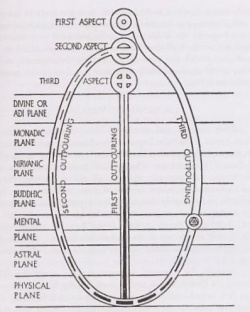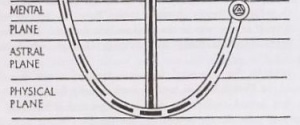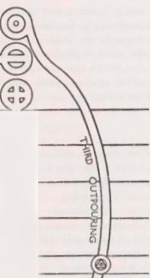Three Great Outpourings
The Three Great Outpourings of the Divine Life are evolutionary forces emanated from the three aspects of the Solar Logos, from which arise all forms of manifested life. The first outpouring coming from the Third Logos develops the seven planes, the next outpouring coming from the Second Logos develops the pre-human kingdoms of nature through which consciousness evolves, and the third outpouring coming from the First Logos develops a human soul in the highest animal forms, thus starting the human stage of evolution.
Three aspects of the Logos
In his book Man Visible and Invisible, C. W. Leadbeater explains that "Man is the resultant of an elaborate and beautiful evolutionary scheme, and in him three streams of divine life may be said to converge.[1]
These three streams of divine life, called the "three great outpourings," are connected to the three aspects of the Logos of our solar system:
Each of the three Aspects or Persons or Manifestations of the Logos has an especial part to play in the preparation and development of the soul of man. What these parts are we shall endeavor to make clear by the help of the following diagram. The horizontal subdivisions indicate the planes, and above them will be seen three symbols belonging to the series described by Madame Blavatsky in The Secret Doctrine. The highest represents the First Aspect of the Logos, and bears only a central dot, signifying the primary manifestation in our system. The Second Aspect of the Logos is symbolized by a circle divided by a diameter, showing the dual manifestation which is always associated with the Second Person of any of the Trinities, while the lowest circle contains the Greek Cross, one of the most usual symbols of the Third Aspect.
First Outpouring
In explaining how a new solar system is built, C. W. Leadbeater talks about a first "outpouring" of divine life coming from the Universal Mind. This outpouring is responsible for the development of the differentiated matter necessary for the new system:
The outpouring which comes first in time is from that principle of our Logos which corresponds to the mind in man, though of course on an infinitely higher plane. This is usually spoken of as the Third Logos, or Mahat, corresponding to the Holy Ghost in the Christian system--the "Spirit of God which broods over the face of the waters" of space, and so brings the worlds into existence.[2]
This outpouring does not "create" matter but, rather, it takes the previously existent homogeneous matter of each of the future seven planes and differentiates it, thus forming the seven "subplanes" within each of the planes:
It is from the Third Aspect that the first movement towards the formation of the system comes. Previous to this movement we have in existence nothing but the atomic state of matter in each of the planes of nature, none of the aggregations or combinations which make up the lower sub-planes of each having yet been formed. But into this sea of virgin matter (the true Virgin Maria) pours down the Holy Spirit, the Lifegiver, as He is called in the Nicene Creed; and by the action of His glorious vitality the units of matter are awakened to new powers and possibilities of attraction and repulsion, and thus the lower subdivisions of each plane come into existence. It will be seen that this is symbolized in the diagram by a line descending from the lowest circle straight through all the planes, growing broader and darker as it comes, to show how the Divine Spirit becomes more and more veiled in matter as it descends, until many are quite unable to recognize it as divine at all. Yet the living force is nevertheless there, even when it is most strictly confined in the lowest of its forms.[3]
The First Outpouring produces the different elements, but no higher structures are developed yet:
It brings into being the material elements, but not bodies formed by their combination. We might have oxygen and hydrogen produced by this outpouring, but not their combination, water; for combination of the elements into bodies of ever-increasing complexity of organized structure and function is the work of the Second Outpouring of the divine life or power.[4]
The fact that this outpouring is the first out of three does not mean that it is no longer active. The atoms formed at the beginning of the system are still evolving under the influence of this outpouring:
At present we are in the fourth round, and only four of these orders of spirillae; are as yet in activity, so that even the very physical matter in which we have to work is very far from having unfolded its full capacities. This mighty process of atomic evolution, which interpenetrates all else and yet moves on its way absolutely independent of all conditions, is ever being carried steadily on by the wonderful impulse of that first outpouring from the Third Aspect of the Logos.[5]
Second Outpouring
According to C. W. Leadbeater, once the raw material of the system has been developed, the second stream of divine life commences its work by plunging into the depths of matter:
In the course of involution the Second great Outpouring of divine Life descends from the Second Logos into the matter already vivified by the Third Logos."[6]
This outpouring induces the slow evolution of seven life-waves in the seven kingdoms of nature. The divine life will take the whole period of evolution of a Planetary Chain to finish its evolution in any given kingdom:
Very slowly and gradually this resistless flood pours down through the various planes and kingdoms, spending in each of them a period equal in duration to one entire incarnation of a planetary chain, a period which, if measured as we measure time, would cover many millions of years. This flood is symbolized in the diagram by the line which, starting from the second of the circles, sweeps down the left-hand side of the oval, gradually darkening as it approaches its nadir.
After passing that point it commences its upward arc and rises through the physical, astral and lower mental planes until it meets the third great outpouring, which is typified by the line starting from the highest circle and forming the right-hand side of the great oval.[7]
At different stages of its descent it is called by special names. As a whole, it is often spoken of as monadic essence, more especially when clothed only in the ultimate matter of the various planes; but when on its downward course it energises in the matter of the higher part of the mental plane, it is known as the First Elemental Kingdom. After spending a whole chain-period in that evolution, it descends to the lower or rupa levels of the same plane, and there it ensouls the Second Elemental Kingdom for another chain-period. Its next aeon is spent on the astral level, where it is called the Third Elemental Kingdom, or very often simply elemental essence of the astral plane. At both of these stages it is very intimately connected with man, as it enters largely into the composition of his various vehicles, and influences his thought and action.[8]
The divine life in this outpouring continues to descend into matter through the Elemental Kingdoms until it reaches the mineral on the physical plane. This is the turning point of the journey, after which it begins its ascending arc toward the mental plane, which culminates in the development of the human kingdom upon meeting the third outpouring:
The monadic essence ensouls the matter . . . on each plane or division of a plane, and thus forms the Elemental Kingdoms. It is the same life that goes on into the mineral kingdom, and then begins to ascend, and proceeds through the vegetable and animal kingdoms until, upon its junction with rays from the life of the First Logos, human beings are formed.[9]
In this U-shaped journey, the divine life develops forms with progressively wider consciousness, gradually extending its reach from the physical up to the mental plane:
On the downward arc of its mighty curve this monadic essence simply aggregates round itself the different kinds of matter on the various planes, so that all may be accustomed and adapted to act as its vehicles; but when it has reached the lowest point of its destined immeshing in matter, and turns to begin the grand upward sweep of evolution towards divinity, its object is to develop consciousness in each of these grades of matter in turn, beginning of course with the lowest. Thus it is that man, although possessing in a more or less latent condition so many higher principles, is yet for a long time at first fully conscious in his physical body only, and afterwards very gradually becomes so in his astral vehicle, and later still in his mind-body.[10]
But in order to form a man, the participation of the last outpouring is needed.
Third Outpouring
The last outpouring of divine life, which accomplishes the transformation of an animal into a human, comes from the highest aspect of the Logos.
The life from God that flashes . . . in the Third Outpouring from the First Logos, at the moment of individualization . . . makes the animal into a human being, not perfected yet, of course, but capable of perfection.[11]
The third outpouring is different from the previous two in that (a) it does not descend all the way to the physical plane, and (b) it acts only on individuals that have reached the necessary evolutionary development:
This final outpouring is not like the others, a mighty outrush affecting thousands or millions simultaneously; it comes to each one individually as that one is ready to receive it. This outpouring has already descended as far as the intuitional world; but it comes no farther than that until this upward leap is made by the soul of the animal from below [i.e., the lower mental world]. But when that happens, this Third Outpouring leaps down [from the buddhic plane] to meet it, and in the higher mental world is formed an ego, a permanent individuality--permanent, that is, until, far later in his evolution, the man transcends it and reaches back to the divine unity from which he came.[12]
It is only when in the highest of the domestic animals [the monadic essence] reaches [the lower mental] stage that the possibility of the third outpouring comes within measurable distance. For this third wave of divine life can descend of itself no lower than our buddhic plane, and there it seems as it were to hover, waiting for the development of fit vehicles to enable it to come down one step further and be the individual souls of men. The phrase sounds strange, but it is difficult to express accurately in human words the mysteries of the higher life. . .[13]
From that monadic essence is formed the causal body--that resplendent sphere of living light into which the still more glorious light from above descends, and by means of which that divine spark is enabled to express itself as a human individuality. . . . It must be remembered that without the preparation of this vehicle to act as a connecting link the immortal individuality of man could never come into being.[14]
The third outpouring of the divine life, which comes from the first aspect of the Logos, and makes within each man that distinctive "spirit of the man which goeth upward" . . . towards the divinity from which it came. This third wave of life is represented by the band on the right in the diagram, and it will be noticed that in this case the outpouring does not become darker or more materialized as it proceeds. It appears to be unable of itself to descend lower than the Buddhic plane, and there it hovers like a mighty cloud, waiting for an opportunity of affecting a junction with the second outpouring, which is slowly rising to meet it. Although this cloud seems to exercise a constant attraction upon the essence below it, yet the development which makes the union a possibility must be made from below.[15]
The link between the two is formed by a triangle in a circle, representing the individual soul of man--the reincarnating ego. Here the triangle [higher triad] is contributed by the third outpouring and the circle [causal body] by the second.[16]
This marks the birth of the individual human monad, which is immortal:
It is only in the presence within him of this third outpouring of the divine life that man possesses an absolute guarantee of his immortality. . . . A time will come, so we are told, though to our intellect it may well seem unthinkable--the time of the universal rest, called in the East the night of Brahma--when "all things visible and invisible" will be re-absorbed into That from which they came; when even the Second and Third Logoi themselves, and all that is of their essence, must for the time sink into sleep and disappear. But even in that period of universal rest there is one Entity who remains unaffected; the First, the Unmanifested Logos, rests still, as ever, in the bosom of the Infinite. And since the direct essence of this, the divine Father of all, enters into the composition of the spirit of man, by that almighty power his immortality is absolutely assured.[17]
Notes
- ↑ C. W. Leadbeater, Man Visible and Invisible (Adyar, Madras: Theosophical Publishing House, 1974), 21.
- ↑ C. W. Leadbeater, The Christian Creed (London: Theosophical Publishing House, 1920), 37-38.
- ↑ C. W. Leadbeater, Man Visible and Invisible (Adyar, Madras: Theosophical Publishing House, 1974), 28.
- ↑ C. W. Leadbeater, Hidden Life in Freemasonry (Adyar, Madras: Theosophical Publishing House, ???), ???
- ↑ C. W. Leadbeater, The Christian Creed (London: Theosophical Publishing House, 1920), 112.
- ↑ C. W. Leadbeater, Hidden Life in Freemasonry,
- ↑ C. W. Leadbeater, Man Visible and Invisible (Adyar, Madras: Theosophical Publishing House, 1974), 29.
- ↑ C. W. Leadbeater, Man Visible and Invisible (Adyar, Madras: Theosophical Publishing House, 1974), 30.
- ↑ C. W. Leadbeater, Hidden Life in Freemasonry,
- ↑ C. W. Leadbeater, The Christian Creed (London: Theosophical Publishing House, 1920), ???.
- ↑ C. W. Leadbeater, Hidden Life in Freemasonry
- ↑ C. W. Leadbeater, Textbook of Theosophy,
- ↑ C. W. Leadbeater, The Christian Creed (London: Theosophical Publishing House, 1920), 58-59.
- ↑ C. W. Leadbeater, The Christian Creed (London: Theosophical Publishing House, 1920), 61.
- ↑ C. W. Leadbeater, Man Visible and Invisible (Adyar, Madras: Theosophical Publishing House, 1974), 48-49.
- ↑ C. W. Leadbeater, The Christian Creed (London: Theosophical Publishing House, 1920), 40-41.
- ↑ C. W. Leadbeater, The Christian Creed (London: Theosophical Publishing House, 1920), 62-63.



